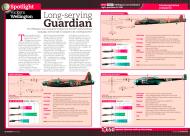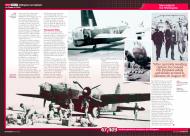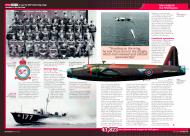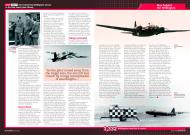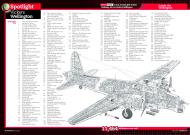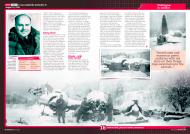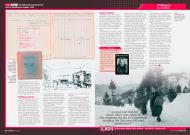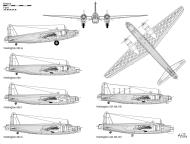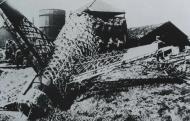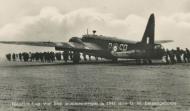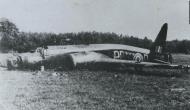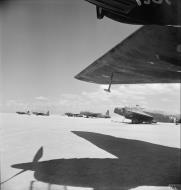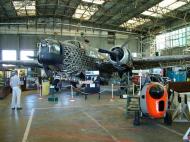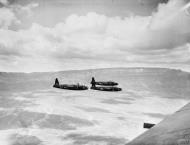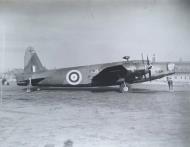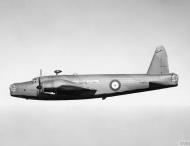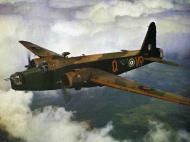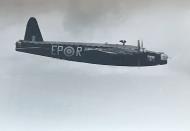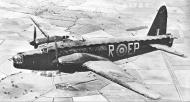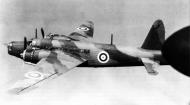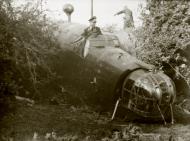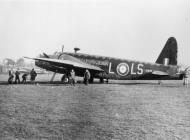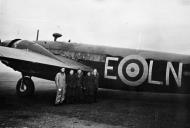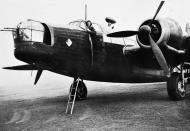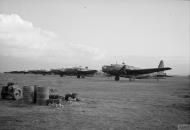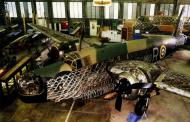Vickers Wellington Photo's
Vickers Wellington MkIA RAF Central Gunnery School White 5 N28887 England 1943
Photograph Source: Flugzeug Classic 2010-11
Artwork Vickers Wellington MkIb RAF 148Sqn ZNBS L4302 England winter 1938-39
Artwork technical drawing showing British WW2 medium bombers comparison
Artwork technical drawing Vickers Wellington MkIa
RNZAF New Zealand Vickers Wellington MkI bombers in England 1939
Vickers Wellington being loaded 01
Vickers Wellington GR.Mk.VIII RAF 172Sqn WNA on patrol over the Western Approaches 1942
Vickers Wellington GR.Mk.VIII RAF 221Sqn Greece Oct 1944
Vickers Wellington GR.Mk.XI RAF dispersal area JA144
Vickers Wellington KAZ 01-02
Vickers Wellington mine detector 01
Vickers Wellington Mk2 RAF EPR 01-03
Vickers Wellington MkIa N2980
Vickers Wellington MkIA RAF 75Sqn AAA SqLr CE Kay P9206 Fetwell Norfolk 01
Vickers Wellington MkIA RAF 218Sqn HAL R1448 Marham Norfolk 01
Vickers Wellington MkIa showing geodesic construction through the perspex windows
Vickers Wellington MkIC RAF 37Sqn LFP L7779 inflight over England June 1940 01
Vickers Wellington MkIII RCAF 425Sqn KWE X3763 Alouette 01
Vickers Wellington MkIII RCAF VRQ 01-02
Vickers Wellington MkX RCAF 428Sqn NAY HE239 showing battle damage April 1943
Vickers Wellington RAF crashed 01
Vickers Wellington RCAF QJW 01
Vickers Wellington Mk.III RAF 30OTU BTZ BK347 which later crashed near Ingleton North Yorkshire 21st April 1944
Vickers Wellington MkIc RAF 215Sqn LGG N2912 No11 OTU Bassingbourn Cambridgeshire England 1940 01
Vickers Wellington RAF 304Sqn Coastal Command Britain Nov 1942 01
Vickers Wellington RAF 6Sqn Engalnd 01
Members of the British 6th bomber squadron 75 Vickers Wellington bombers . The squadron crewed mainly by New Zealanders, however, crews often consisted of British and other countries of the British Commonwealth. The main tasks of the squadron were night raids on targets in occupied Europe. By the end of the war, almost one thousand members of 75 Squadron perished.
Wellington X RAF 150Sqn LN323 at taking off from Kairouan West Tunisia IWM CNA1269
Wellington Mark X, LN323, of No. 150 Squadron RAF, taking off from Kairouan West, Tunisia, to take part in the interdiction bombing of communications targets around Salerno. Italy, on the evening before the Allied landings there, (Operation AVALANCHE).
Imperial War Museum IWM CNA 1269 https://www.iwm.org.uk/collections/item/object/205209266
Wellington X RAF 150Sqn crew pre-take off briefing at Kairouan West Tunisia IWM CNA1271
The crew of a Vickers Wellington Mark X of No. 150 Squadron RAF receive a final briefing from their flight commander before taking off from Kairouan, Tunisia, for a raid on targets in the Salerno area on the day before the Allied landings there, (Operation AVALANCHE). Pictured are, (left to right): Sergeant J Umbers of Coulsdon, Surrey, (wireless operator/air gunner); Sergeant J Baxter of Ayrshire, Scotland, (bombardier); Squadron Leader E Le P Langlois of Clarence Park, South Australia, (Commander, 'A' Flight); Flight Sergeant S S M Tunstall of Boonah, Queensland, Australia, (pilot); Sergeant F Doyle of Crosby, Liverpool, (navigator), and Sergeant M Hayes of Lismore, Eire, (rear gunner).
Imperial War Museum IWM CNA 1271 https://www.iwm.org.uk/collections/item/object/205209266
Wellington X RAF 205Sqn during Operation AVALANCHE Tunisia IWM CNA1272
Armourers hurry a trolley load of 500-lb GP bombs to an awaiting Vickers Wellington Mark X of No. 205 Group RAF, which is being refuelled in preparation for a night raid on targets in the Salerno area, on the day before the Allied landings there, (Operation AVALANCHE). The aircraft's front turret has been shrouded to shield it from the North African heat.
Imperial War Museum IWM CNA 1272 https://www.iwm.org.uk/collections/item/object/205209267
Wellington X RAF 150Sqn LN323 at Kairouan Tunisia IWM CNA1282
Corporal M Piper of Stafford stands on an oil drum to service the front turret of a Vickers Wellington Mark X of No. 150 Squadron RAF, at Kairouan, Tunisia, prior to bombing operations in support of Operation AVALANCHE, the Allied landings at Salerno, Italy. Behind him, local porters can be seen carrying water and supplies across the airfield.
Imperial War Museum IWM CNA 1282 https://www.iwm.org.uk/collections/item/object/205209269
Vickers Wellington GRMkVIII RAF 221Sqn based at Kalamaki Greece Oct 1944 IWM CNA4680
Vickers Wellington Mark XIIIs of No. 221 Squadron RAF based at Kalamaki, Greece, parked on Sedes airfield after transporting men and supplies to the Allied forces operating in the Salonika area.
Imperial War Museum IWM CNA4680 https://www.iwm.org.uk/collections/item/object/205209622
Vickers Wellington XIII RAF 221Sqn F MF263 based at Kalamaki Greece Oct 1944 IWM CNA4682
Vickers Wellington Mark XIII, MF263 'F', of No. 221 Squadron RAF based at Kalamaki, Greece, parked on Sedes airfield after transporting men and supplies to the Allied forces operating in the Salonika area.
Imperial War Museum IWM CNA4682 https://www.iwm.org.uk/collections/item/object/205209624
Vickers Wellington X RAF 70Sqn A LN640 based at Tortorella Italy IWM CNA2830
Vickers Wellington Mark X, LN640 'A', of No. 70 Squadron RAF taxies to the main runway at at Tortorella, Italy, for a night bombing operation as a Boeing B-17 of the 99th Bomb Group, 15th USAAF, comes in to land.
Imperial War Museum IWM CNA2830 https://www.iwm.org.uk/collections/item/object/205209376
Wellington Ic RAF 37Sqn LFK LFC LFE at Shallufa Egypt IWM CM501
Three Vickers Wellington Mark ICs of No. 37 Squadron RAF based at Shallufa, Egypt, in flight over the Western Desert.
Imperial War Museum IWM CM 501 https://www.iwm.org.uk/collections/item/object/205208739
Wellington Ic RAF 37Sqn LFO T2508 at Koraiyim Egypt IWM CM407
The nose insignia on Vickers Wellington Mark IC, T2508 'LF-O', of No. 37 Squadron RAF at an Advanced Landing Ground in Egypt. Each emblem represents a member of the crew under the devices of the aircraft's captain, Flying Officer P C "Cheese" Lemon.
Imperial War Museum IWM CM 407 https://www.iwm.org.uk/collections/item/object/205208736
Wellington Ic RAF 37Sqn LFO T2508 at Koraiyim Egypt IWM CM368
Vickers Wellington Mark ICs of No. 37 Squadron RAF, being prepared for a raid at an Advanced Landing Ground in the Western Desert, probably LG 09/Bir Koraiyim, during bombing operations against Italian ports and airfields in Libya. Groundcrew are about to refuel T2508 'LF-O', which has just had its port mainwheel replaced after bursting a tyre on landing.
Imperial War Museum IWM CM 368 https://www.iwm.org.uk/collections/item/object/205208735
Wellington X RAF 150Sqn Amendola Italy IWM CNA2785
A Boeing B-17 crew of the 5th Bombardment Wing, 15th USAAF, after returning to Amendola, Italy, from a daylight bombing mission over Sofia, Bulgaria, have driven over to the dispersals of No. 150 Squadron RAF to wish a crew of a Vickers Wellington Mark X good luck before they take off for a night raid on the same target. The RAF crew are, (right to left): Sergeant M Jefferson of Manchester, (wireless operator); Sergeant G Heywood of Upton-by-Chester, (rear gunner); Flight Lieutenant V T "Bill" Skehill of Kooyong, Australia, (pilot), who is shaking hands with the American crew captain, 2nd Lieutenant Walters; Flying Officer P R Jameson of Brisbane, Australia, (navigator), and Flight Sergeant E W Turner of Northfleet, Kent, (bomb aimer).
Imperial War Museum IWM CNA 2785 https://www.iwm.org.uk/collections/item/object/205209370
Wellingtons RAF 40Sqn at Foggia Main Italy IWM CNA2742
Line of Vickers Wellington Mark IIIs and Mark Xs, possibly No. 40 Squadron RAF at Foggia Main, Italy.
Imperial War Museum IWM CNA 2742 https://www.iwm.org.uk/collections/item/object/205209368
Wellington X RAF 40Sqn D at Foggia Main Italy IWM CNA2699
An aircrew of No. 40 Squadron RAF gather by their Vickers Wellington Mark X at Foggia Main, Italy, befor setting off on a night bombing mission.
Imperial War Museum IWM CNA 2699 https://www.iwm.org.uk/collections/item/object/205209366
Wellington III RAF 40Sqn GX DF542 at Foggia Main Italy IWM CNA2705
Vickers Wellington Mark IIIs and Mark Xs of No. 40 Squadron RAF being prepared for a night bombing mission at Foggia Main, Italy. In the foreground is Mark III, DF542 'G-X'.
Imperial War Museum IWM CNA 2705 https://www.iwm.org.uk/collections/item/object/205209365
Wellingtons RAF 40Sqn at Foggia Main Italy IWM CNA2704
Vickers Wellington Mark IIIs and Mark Xs of No. 40 Squadron RAF being prepared for a night bombing mission at Foggia Main, Italy.
Imperial War Museum IWM CNA 2704 https://www.iwm.org.uk/collections/item/object/205209364
Wellington III RAF 150Sqn JNA possibly HF482 based at Blida Algeria IWM CNA226
The nose of Vickers Wellington B Mark III, (possibly HF482) 'JN-A' "A for Apple", of No. 150 Squadron RAF at Blida, Algeria, showing a bomb tally indicating 16 completed missions, and nose artwork depicting Captain Reilly-ffoul, a villainous character in the "Just Jake" cartoon strip by Bernard Graddon, which appeared in the Daily Mirror throughout the war.
Imperial War Museum IWM CNA 226 https://www.iwm.org.uk/collections/item/object/205209187
Wellington III RAF 150Sqn based at Blida Algeria IWM CNA225
Vickers Wellington B Mark IIIs of No. 150 Squadron RAF under maintenance prior to receiving their bomb loads at Blida, Algeria.
Imperial War Museum IWM CNA 225 https://www.iwm.org.uk/collections/item/object/205209186
Vickers Wellington Ic RAF P9249 factory fresh in flight March 1940 IWM HU104762
Vickers Wellington Ic RAF P9249 factory fresh in flight March 1940 IWM HU104763
Vickers Wellington Mk IC P9249 in flight, March 1940.
Imperial War Museum IWM HU 104762 https://www.iwm.org.uk/collections/item/object/205229917
Imperial War Museum IWM HU 104763 https://www.iwm.org.uk/collections/item/object/205229919
Vickers Wellington I RAF L4251 factory fresh in flight March 1940 IWM HU104761
Vickers Wellington Mk IC L4251 in flight, March 1940.
Imperial War Museum IWM HU 104761 https://www.iwm.org.uk/collections/item/object/205229912
Vickers Wellington II RAF 104Sqn EPK W5444 at Driffield autumn 1941 IWM HU75017
Vickers Wellington II W5444/EP-K of No 104 Squadron awaits delivery of its bomb load of 250 and 500 pounders at Driffield, autumn 1941.
Imperial War Museum IWM HU 75017 https://www.iwm.org.uk/collections/item/object/205075637
Vickers Wellington RAF crew after the first raid on Berlin 25-26 Aug 1940 IWM HU104670
Wellington bomber pilot photographed in his aircraft at a press event after the first raid on Berlin, which took place on the night of 25/26 August 1940.
Imperial War Museum IWM HU 104670 https://www.iwm.org.uk/collections/item/object/205229864
Vickers Wellington RAF crews after the first raid on Berlin 25-26 Aug 1940 IWM HU104669
Wellington bomber crews photographed at a press event after the first raid on Berlin, which took place on the night of 25/26 August 1940.
Imperial War Museum IWM HU 104669 https://www.iwm.org.uk/collections/item/object/205229863
Citations:
- Richards 1995, p. 115.
- Building a bomber plane in just a day. BBC News Magazine, 13 September 2010.
- Workers weekend. The National Archives. Retrieved: 23 September 2011.
- Richards 1953, p. 46.
- Jackson 2007, p. 217.
- Gilman and Clive 1978, p. 314.
- Andrews 1970, pp. 44–56.
- Simpson, Andrew. Vickers Wellington X MF628/9210M: Museum Accession Number 69/A/17. Royal Air Force Museum. Retrieved: 13 January 2008.
- Pewter Aircraft Wellington DWI page. Pewter Aircraft. Retrieved: 14 January 2008.
- Vickers Wellington X. Royal Air Force Museum. Retrieved: 13 January 2008.
- Andrews and Morgan 1988, p. 340.
- 4× from Mark III onwards
- deleted from Mark III onwards
Bibliography:
- Andrews, C.F. The Vickers Wellington I & II (Aircraft in Profile 125). Leatherhead, Surrey: Profile Publications Ltd., 1970, First edition 1967. No ISBN.
- Andrews, C.F and E.B. Morgan. Vickers Aircraft since 1908. London: Putnam, 1988. ISBN 0-85177-815-1.
- Bowman, Martin. Wellington, The Geodetic Giant. Shrewsbury, UK: Airlife Publishing Ltd., 1989. ISBN 1-85310-076-5.
- Bowyer, Chaz. Wellington at War. Shepperton, Surrey: Ian Allan Ltd., 1982. ISBN 0-7110-1220-2.
- Bowyer, Chaz. Wellington Bomber. London: William Kimber & Co Ltd., 1986. ISBN 0-7183-0619-8.
- Cooksley, Peter G. Wellington, Mainstay of Bomber Command. Wellingborough, Northhamptonshire: Patrick Stephens Ltd., 1987. ISBN 0-85059-851-6.
- Crosby, Francis. The World Encyclopedia of Bombers. London: Anness Publishing Ltd., 2007. ISBN 1-84477-511-9.
- Delve, Ken. Vickers Armstrong Wellington. Ramsbury, Wiltshire, UK: The Crowood Press Ltd., 1998. ISBN 1-86126-109-8.
- Flintham, V. Air Wars and Aircraft: A Detailed Record of Air Combat, 1945 to the Present. New York: Facts on File, 1990. ISBN 0-8160-2356-5.
- Gilman J.D. and J. Clive. KG 200. London: Pan Books Ltd., 1978. ISBN 0-85177-819-4.
- Hall, Alan W. Vickers Wellington, Warpaint Series No. 10. Husborne Crawley, Berfordshire: Hall Park Books Ltd., 1997. No ISBN.
- Jackson, Robert. Britain's Greatest Aircraft. Barnsley, UK: Pen & Sword Books Ltd., 2007. ISBN 978-1-84415-383-1.
- Lihou, Maurice. Out of the Italian Night: Wellington Bomber Operations 1944-45. Shrewsbury, UK: Airlife Publishing Ltd., 2003. ISBN 1-84037-405-5.
- Lumsden, Alec. Wellington Special. Shepperton, Surrey: Ian Allan Ltd., 1974. ISBN 0-7110-0527-3.
- Mackay, Ron. Wellington in Action, Aircraft Number 76. Carrollton, Texas: Squadron/Signal Publications, Inc., 1986. ISBN 0-89747-183-0.
- Murray, Dr. Iain Bouncing-Bomb Man: The Science of Sir Barnes Wallis. Haynes. ISBN 978-1-84425-588-7.
- Ovčáčík, Michal and Karel Susa. Vickers-Armstrongs Wellington Medium Bomber variants. Prague, Czech Republic: 4+ Publications, 2003. ISBN 80-902559-7-3.
- Richards, Denis. The Hardest Victory: RAF Bomber Command in the Second World War. London: Coronet Books, 1995. ISBN 0-340-61720-9.
- Richards, Denis. Royal Air Force 1939–1945: Volume I The Fight at Odds. London: HMSO, 1953.
- Tarring, Trevor and Mark Joseland. Archie Frazer-Nash .. Engineer. London: The Frazer Nash Archives, 2011. ISBN 978-0-9570351-0-2.
Web References: +
- History of RAF Organisation: http://www.rafweb.org
- IWM London Lambeth Road London SE1 6HZ Webstite http://www.iwm.org.uk
- Wikipedia, the free encyclopedia: http://en.wikipedia.org/
 Editor for Asisbiz: Matthew Laird Acred
Editor for Asisbiz: Matthew Laird Acred
If you love our website please add a like on facebook
Please donate so we can make this site even better !!


